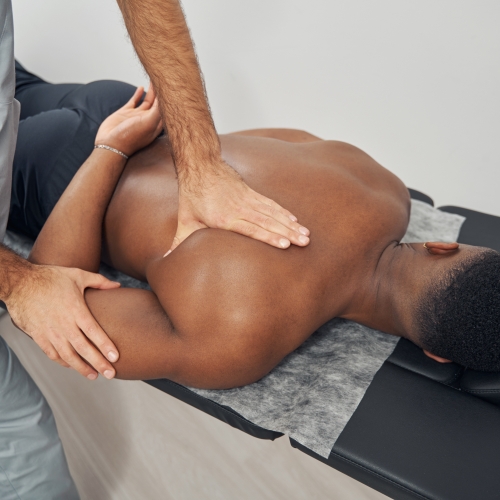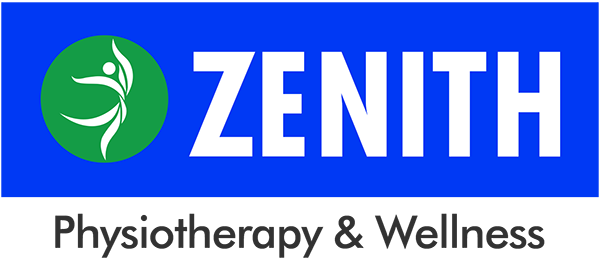Move Your Shoulders With Ease Once Again Through Physiotherapy!
You Don’t Have to Live with Tight or Achy Shoulders
Because we use our shoulders for almost every movement, it’s a big deal if they bother us!
There are numerous causes of shoulder pain, and the severity of the pain can range from minor discomfort caused by a pulled muscle to agonizing bone-on-bone friction caused by arthritis.
Shoulder pain can develop as a result of an injury, giving you the impression that your shoulder is immobile.
Shoulder pain can also appear in a variety of ways, such as reaching for the top shelf to put away dishes or struggling to find a comfortable sleeping position.
Whatever the source of your shoulder pain, Zenith Physiotherapy and Wellness is dedicated to providing you with natural pain relief options.

Why should I consider PT for shoulder pain/injury?
Rotator cuff injuries, also known as “torn shoulders,” are commonly associated with deep shoulder pain, arm weakness, difficulty reaching behind the back, and difficulty sleeping due to pain.
Depending on the severity and situation, surgery may be required, but proper physiotherapy can often help reduce pain and restore strength to the rotator cuff in order to avoid surgical intervention. If surgery is required, physiotherapy will be an important part of the recovery process.
According to the American Physiotherapy Association, “a recent Finnish study asserts that when it comes to the treatment of nontraumatic rotator cuff tears, physiotherapy alone produces results comparable to arthroscopic surgery and open surgical repair.”
Zenith Physiotherapy and Wellness’s natural and non-invasive methods can help relieve shoulder pain and heal rotator cuff injuries.

How can physiotherapy relieve shoulder pain?
Physiotherapy is a natural, simple, and comfortable way to relieve shoulder pain that does not involve the use of harmful drugs or invasive surgery.
Our Airdrie physiotherapists have treated a wide range of shoulder pain conditions, with many patients experiencing improvement and relief after only a few short sessions.
Physiotherapists are movement specialists who have been trained to use a variety of diagnostic tests and methods to prevent and monitor pain.
During your assessment, we will look at your range of motion, strength, coordination, medical history, joint mobility, and joint motion mechanics.
Once your physiotherapist has identified the source of your shoulder pain, they will be able to create a personalized treatment plan to manage and relieve your discomfort.
Gentle manual therapy may be included in your treatment plan to aid in the restoration of normal joint movement, the relief of soft tissue restrictions, and the promotion of circulation. Specific therapeutic exercises to restore strength and a proper muscle activation sequence around the shoulder joint may also be included.
Another benefit of physiotherapy is that you will learn new ways to move your body in order to increase your strength and avoid future shoulder problems.
Why it’s important to have comfortable shoulder movements
The shoulder is a “ball-and-socket” joint, which means that the head of the upper arm bone (or “humerus”) fits perfectly into the corresponding space within the shoulder blade (or “scapula”), and the ends of the bones are protected by a thick layer of cartilage, preventing bone friction.
Tendons are also protected from rubbing against bones by fluid-filled bags called “bursae.” Tendons connect the bones within the shoulder to another group of bones known as the rotator cuff.
Your shoulders can perform a variety of physical feats. In fact, they have the most movement of any joint in your body! That’s why shoulder pain and discomfort brings with it a variety of complications.
The type of pain you feel in your shoulder will depend on what is causing it. Impingement pain, for example, occurs when you raise your arm from a specific point of ROM (range of motion).
When you move your arm in certain directions, a degenerated shoulder can cause persistent aches. Acute injuries can cause sudden and intense pain, making shoulder movement impossible.
Pain can also occur if something goes wrong with the complexities that comprise the shoulder’s mechanical interplay.
What’s causing my shoulder pain?
Some of the most common causes of shoulder pain include:
Arthritis
The two main forms of arthritis that affect the shoulder are osteoarthritis and rheumatoid arthritis. Both of these result in loss of motion, weakness to the shoulder muscles, and difficulty performing normal, daily tasks.
Rheumatoid arthritis occurs when the immune system decides to attack the membranes surrounding the shoulder joint, resulting in pain and inflammation.
Osteoarthritis occurs when the cartilage in the shoulder joint experiences significant “wear and tear,” typically due to age or excessive overuse.
Impingement
Impingement typically occurs because of abnormal movement and tracking of the humeral head as you lift your arm overhead.
Pain typically occurs when lifting your arm at or above 90 degrees.
Frozen shoulder
Frozen shoulder results in a painful loss of motion in the shoulder with a tightening of the shoulder joint that severely limits motion. It is also known as “adhesive capsulitis.”
This condition can occur if your arm has been in a cast or sling for a while, or if you have been bedridden for an extended period.
Some ethnicities are more predisposed, and women from 40-60 years of age tend to have more instances of this condition than men.
Tendinitis
Tendinitis occurs when the shoulder joint is excessively overused typically due to the physical demands of a person’s job, overhead activity, or sport.
Another factor for tendinitis is also poor posture because this alters the normal forces on the tendons, and can set you up for tendon injury.
This causes the tendons to undergo ongoing inflammation, resulting in swelling and painful impingement when raising your arm.
Contact us for effective shoulder pain relief
Shoulder pain may be controlling your life, but it doesn’t have to! Our Airdrie physiotherapy practice will give you the help you need to get back to doing the things you enjoy without pain.
Your Next Steps…
Request An Appointment
Receive A Custom Treatment Plan
Work Hard and Progress In Your Recovery
Recover & Enjoy Life Pain-Free!




